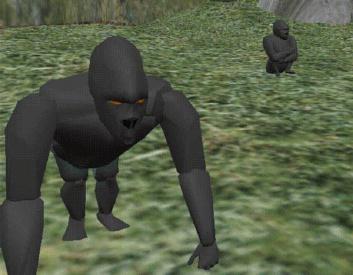The Virtual Gorilla Exhibit: Teaching Principles of Zoo Habitat Design
Using an Immersive Virtual Environments Application

In this project, we are extending the Virtual
Reality Gorilla Exhibit for use as a habitat design and exploration
tool. In conjunction with the College
of Architecture, we are planning to use this tool within a graduate
level class on zoo design principles. Students will be allowed to immersively
experience the main gorilla habitat at Zoo
Atlanta. They will also be able to gather information regarding habitat
design principles, create, delete, or modify design elements, and experiment
with different visitor viewpoints.
Design Information
The main component of this tool will be embedded information. Audio
annotations, text descriptions, and photographic images are scattered throughout
the gorilla habitat. As the user explores, he or she can gather information
related to the design decisions made when the habitat was created. Receiving
this information while embedded within the virtual environment should allow
students to create strong mental associations, and should give them a desire
to learn more about the subject.
Interactive Tasks
Students will also participate interactively in the design process through
the use of several interactive tasks. One task allows the user to position
trees, rocks, and other design elements in order to see the effect of these
changes on the habitat from both the animal's and visitor's point of view.
Students can also interactively change features of the terrain. Finally,
users can experiment with the placement and size of visitor viewing positions,
in order to maximize the viewability of the animals while preserving some
private spaces and ensuring that visitors do not see each other from different
viewpoints.
Interaction Techniques
In a functionally complex application, it is imperative that great care
be paid to the design of interaction techniques for usability. In our application,
we are also concerned that the interaction techniques do not command so
much of the user's attention that the goals of gathering information or
understanding changes in design are lost. Therefore, we have used the results
of experiments we have performed in the areas of travel,
selection/manipulation,
and system control
to optimize the interaction techniques within this application.

Our current set of techniques includes:
-
System control:
Users hold a physical tablet in their non-dominant hand. In the virtual
world, the tablet is transparent, and shows a large map of the environment.
The user's position is represented, as well as other features of interest,
such as the location of audio annotations. Users change interaction modes
by selecting one of the large buttons on the right hand side of the tablet
using a stylus (see the picture above). The tablet may be put down when
not needed, and the physical feedback provided by the real tablet is a
great help in selecting items.
-
Travel:
Users move through the environment by pointing the stylus in the direction
in which they which to travel, then holding down the stylus button. This
allows the user to look in one direction and move in another, which can
be quite helpful in determining spatial relationships and design concepts.
Collision detection ensures that the user cannot move beneath the ground,
through trees or rocks, or outside the environment, but users are allowed
to "fly" upwards to get a bird's eye view of the habitat. To move somewhere
quickly, the user can also select and drag the red dot on the tablet map
anywhere in the environment.
-
Selection/Manipulation:
Students need to be able to grab and position elements such as trees
and rocks easily. Requiring them to move very close to the object in order
to grab it makes this task difficult, especially when the desired object
is far away or very large. We use a simple arm-extension technique developed
at the HIT Lab called the
Go-Go
Technique. As the user stretches her arm away from her body, it grows
at a non-linear rate, allowing the user to reach anything in the environment
from any position. This technique also makes it easy to move the selected
object quickly to a new location.
Project Participants:
Doug Bowman,
College
of Computing
Jean Wineman, College
of Architecture
Larry
Hodges,
College of Computing
Contact Information:
Doug A. Bowman - Graduate Student
Georgia Institute of Technology
College of Computing
Atlanta GA 30332-0280
(404) 894-5104 (Phone)
By E-MAIL :
bowman@cc.gatech.edu


